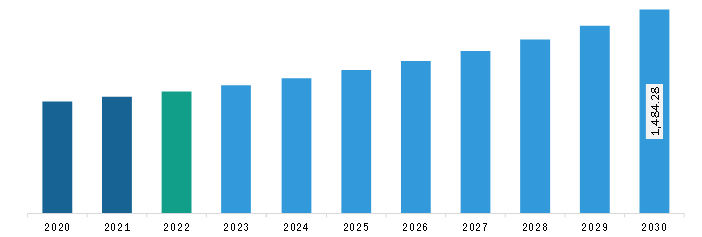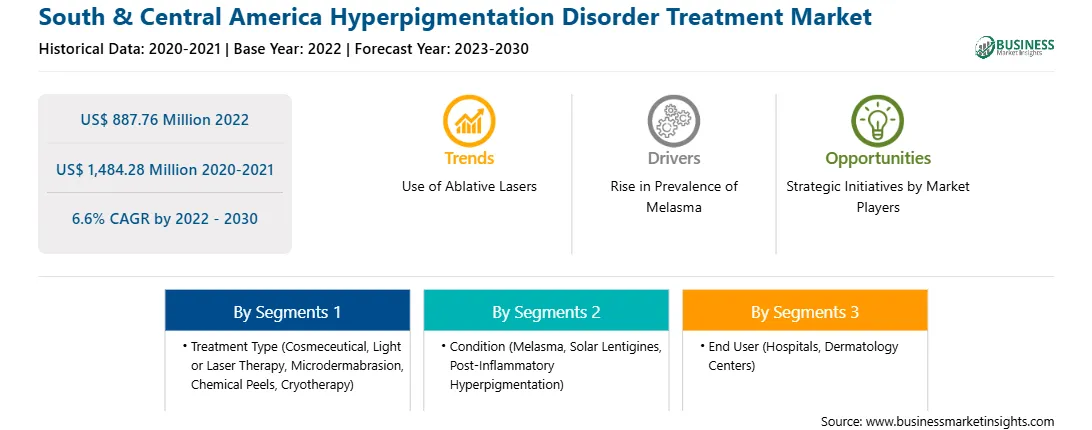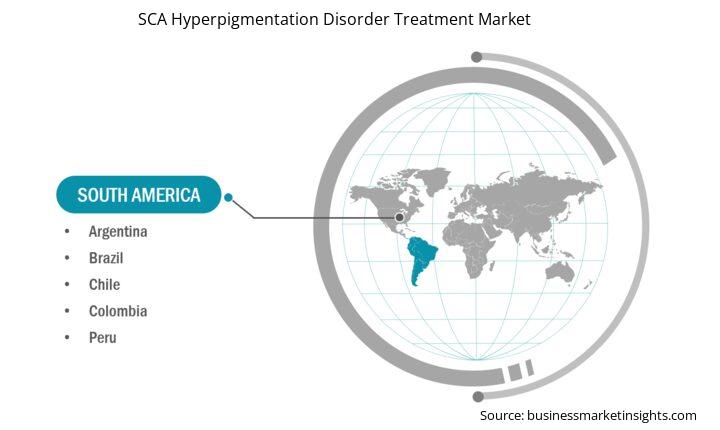The South & Central America hyperpigmentation disorder treatment market was valued at US$ 887.76 million in 2022 and is expected to reach US$ 1,484.28 million by 2030; it is estimated to register a CAGR of 6.6% from 2022 to 2030.
Melasma, one of the most dominant hyperpigmentation conditions, is characterized by symmetrical light to dark muddy-brown macules with borders on the face, particularly the chin, upper lip, nose, forehead, and cheeks. It is prevalent among women and those with darker complexion. Malar, mandibular, and centrofacial clinical features are common in melasma. Sun exposure, hormonal variations, pregnancy, hereditary factors, cosmetics, and medicines have all been linked to the development of melasma. Various studies have estimated that the overall prevalence of melasma in the general population ranges from 1% to 50%. 55–64% of melasma cases have reported a family history of the same condition.
Pregnancy is another common cause of melasma. This condition also impacts women taking oral contraceptives and hormones. Estrogen, progesterone, and melanocyte-stimulating hormone levels normally rise during the third trimester of pregnancy, which may be a factor. According to the National Center for Biotechnology Information (NCBI) in August 2023, melasma is more common in reproductive years, and it rarely occurs before puberty; the condition occurs in 15–50% of pregnant women, and its prevalence ranges from 1.5% to 33%, depending on the population in a different region. Therefore, an upsurge in melasma prevalence triggers the demand for hyperpigmentation treatments.
The hyperpigmentation disorder treatment market in Brazil is experiencing notable growth due to the rising number of hyperpigmentation cases. According to an article published by the Journal of Skin and Stem Cell in January 2022, the prevalence of pigmented phenotypes is higher in Southeast Asian, Middle Eastern, Mediterranean, Hispanic-American, and Brazilian populations. A study based in Brazil presented in the article concluded that melasma was the third most frequent reason for skin-related consultations among 57,343 patients.
Furthermore, with the expansion of healthcare expenditure in Brazil, there is a corresponding rise in investments and resources allocated to dermatological care, including product development activities and the promotion of effective acne medications. This financial boost enhances research and development efforts, fostering the introduction of advanced formulations and treatment options in the market in the country. The improved accessibility to healthcare services and growing skincare awareness further bolsters the demand for hyperpigmentation disorder treatment across the country.
Strategic insights for the South & Central America Hyperpigmentation Disorder Treatment provides data-driven analysis of the industry landscape, including current trends, key players, and regional nuances. These insights offer actionable recommendations, enabling readers to differentiate themselves from competitors by identifying untapped segments or developing unique value propositions. Leveraging data analytics, these insights help industry players anticipate the market shifts, whether investors, manufacturers, or other stakeholders. A future-oriented perspective is essential, helping stakeholders anticipate market shifts and position themselves for long-term success in this dynamic region. Ultimately, effective strategic insights empower readers to make informed decisions that drive profitability and achieve their business objectives within the market. The geographic scope of the South & Central America Hyperpigmentation Disorder Treatment refers to the specific areas in which a business operates and competes. Understanding local distinctions, such as diverse consumer preferences (e.g., demand for specific plug types or battery backup durations), varying economic conditions, and regulatory environments, is crucial for tailoring strategies to specific markets. Businesses can expand their reach by identifying underserved areas or adapting their offerings to meet local demands. A clear market focus allows for more effective resource allocation, targeted marketing campaigns, and better positioning against local competitors, ultimately driving growth in those targeted areas.
South & Central America Hyperpigmentation Disorder Treatment Strategic Insights

South & Central America Hyperpigmentation Disorder Treatment Report Scope
Report Attribute
Details
Market size in 2022
US$ 887.76 Million
Market Size by 2030
US$ 1,484.28 Million
CAGR (2022 - 2030) 6.6%
Historical Data
2020-2021
Forecast period
2023-2030
Segments Covered
By Treatment Type
By Condition
By End User
Regions and Countries Covered
South and Central America
Market leaders and key company profiles
South & Central America Hyperpigmentation Disorder Treatment Regional Insights

The South & Central America hyperpigmentation disorder treatment market is categorized into treatment type, condition, end user, and country.
By treatment type, the South & Central America hyperpigmentation disorder treatment market is segmented into cosmeceutical, light or laser therapy, microdermabrasion, chemical peels, cryotherapy, and others. The cosmeceutical segment held the largest share of the South & Central America hyperpigmentation disorder treatment market share in 2023.
In terms of condition, the South & Central America hyperpigmentation disorder treatment market is segmented into melasma, solar lentigines, post-inflammatory hyperpigmentation, and others. The melasma segment held the largest share of the South & Central America hyperpigmentation disorder treatment market share in 2023.
By end user, the South & Central America hyperpigmentation disorder treatment market is hospitals, dermatology centers, and others. The hospital segment held the largest share of the South & Central America hyperpigmentation disorder treatment market share in 2023.
Based on country, the South & Central America hyperpigmentation disorder treatment market is segmented into Brazil, Argentina, and the Rest of South & Central America. Brazil segment held the largest share of South & Central America hyperpigmentation disorder treatment market in 2023.
AbbVie Inc, Bayer AG, Galderma SA, L’OREAL S.A., Lutronic Co Ltd, Obagi Cosmeceuticals LLC, and Pierre Fabre SA are some of the leading companies operating in the South & Central America hyperpigmentation disorder treatment market.
The South & Central America Hyperpigmentation Disorder Treatment Market is valued at US$ 887.76 Million in 2022, it is projected to reach US$ 1,484.28 Million by 2030.
As per our report South & Central America Hyperpigmentation Disorder Treatment Market, the market size is valued at US$ 887.76 Million in 2022, projecting it to reach US$ 1,484.28 Million by 2030. This translates to a CAGR of approximately 6.6% during the forecast period.
The South & Central America Hyperpigmentation Disorder Treatment Market report typically cover these key segments-
The historic period, base year, and forecast period can vary slightly depending on the specific market research report. However, for the South & Central America Hyperpigmentation Disorder Treatment Market report:
The South & Central America Hyperpigmentation Disorder Treatment Market is populated by several key players, each contributing to its growth and innovation. Some of the major players include:
The South & Central America Hyperpigmentation Disorder Treatment Market report is valuable for diverse stakeholders, including:
Essentially, anyone involved in or considering involvement in the South & Central America Hyperpigmentation Disorder Treatment Market value chain can benefit from the information contained in a comprehensive market report.